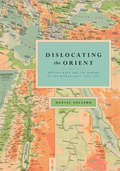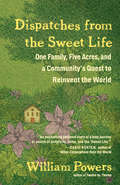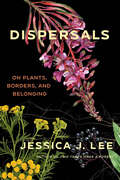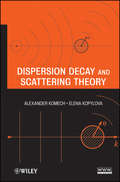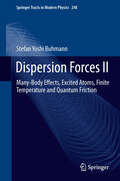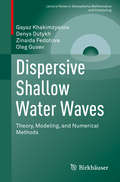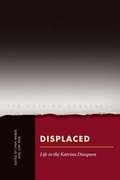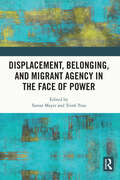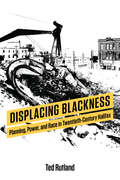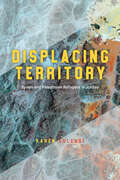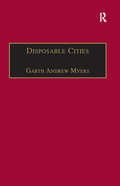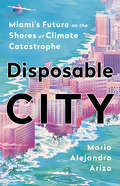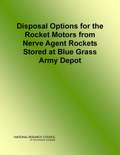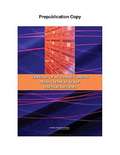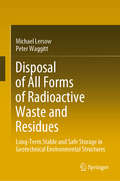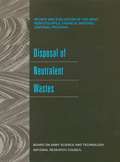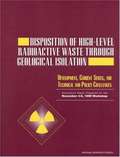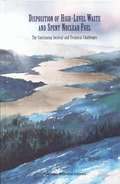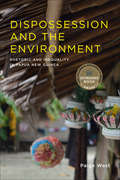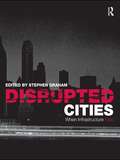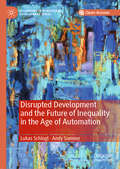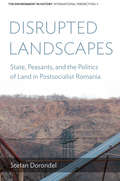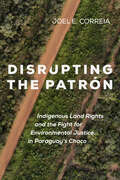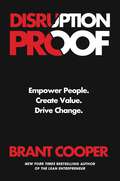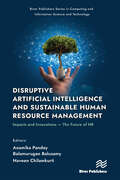- Table View
- List View
Dislocating the Orient: British Maps and the Making of the Middle East, 1854-1921
by Daniel FoliardWhile the twentieth century’s conflicting visions and exploitation of the Middle East are well documented, the origins of the concept of the Middle East itself have been largely ignored. With Dislocating the Orient, Daniel Foliard tells the story of how the land was brought into being, exploring how maps, knowledge, and blind ignorance all participated in the construction of this imagined region. Foliard vividly illustrates how the British first defined the Middle East as a geopolitical and cartographic region in the nineteenth and early twentieth centuries through their imperial maps. Until then, the region had never been clearly distinguished from “the East” or “the Orient.” In the course of their colonial activities, however, the British began to conceive of the Middle East as a separate and distinct part of the world, with consequences that continue to be felt today. As they reimagined boundaries, the British produced, disputed, and finally dramatically transformed the geography of the area—both culturally and physically—over the course of their colonial era. Using a wide variety of primary texts and historical maps to show how the idea of the Middle East came into being, Dislocating the Orient will interest historians of the Middle East, the British empire, cultural geography, and cartography.
Dispatches from the Sweet Life: One Family, Five Acres, and a Community's Quest to Reinvent the World
by William PowersMany fantasize about dramatically changing their lives — living in accordance with their ideals rather than the exigencies of job, bills, and possessions. William Powers actually does it. In his book Twelve by Twelve, Powers lived in an off-grid tiny house in rural North Carolina. In New Slow City, he and his wife, Melissa, inhabited a Manhattan micro-apartment in search of slow in the fastest city in the world. Here, the couple, with baby in tow, search for balance, community, and happiness in a small town in Bolivia. They build an adobe house, plant a prolific orchard and organic garden, and weave their life into a community of permaculturists, bio-builders, artists, and creative businesspeople. Can this Transition Town succeed in the face of encroaching North American capitalism, and can Powers and the other settlers find the balance they’re seeking? Dispatches from the Sweet Life is compelling, sobering, thought-provoking, and, no matter the outcome, inspiring.
Dispersals: On Plants, Borders, and Belonging
by Jessica J. LeeA prize-winning memoirist and nature writer turns to the lives of plants entangled in our human world to explore belonging, displacement, identity, and the truths of our shared futureA seed slips beyond a garden wall. A tree is planted on a precarious border. A shrub is stolen from its culture and its land. What happens when these plants leave their original homes and put down roots elsewhere?In fourteen essays, Dispersals explores the entanglements of the plant and human worlds: from species considered invasive, like giant hogweed; to those vilified but intimate, like soy; and those like kelp, on which our futures depend. Each of the plants considered in this collection are somehow perceived as being &‘out of place&’—weeds, samples collected through imperial science, crops introduced and transformed by our hand. Combining memoir, history, and scientific research in poetic prose, Jessica J. Lee meditates on the question of how both plants and people come to belong, why both cross borders, and how our futures are more entwined than we might imagine.
Dispersion Decay and Scattering Theory
by Alexander Komech Elena KopylovaA simplified, yet rigorous treatment of scattering theory methods and their applicationsDispersion Decay and Scattering Theory provides thorough, easy-to-understand guidance on the application of scattering theory methods to modern problems in mathematics, quantum physics, and mathematical physics. Introducing spectral methods with applications to dispersion time-decay and scattering theory, this book presents, for the first time, the Agmon-Jensen-Kato spectral theory for the Schr?dinger equation, extending the theory to the Klein-Gordon equation. The dispersion decay plays a crucial role in the modern application to asymptotic stability of solitons of nonlinear Schr?dinger and Klein-Gordon equations.The authors clearly explain the fundamental concepts and formulas of the Schr?dinger operators, discuss the basic properties of the Schr?dinger equation, and offer in-depth coverage of Agmon-Jensen-Kato theory of the dispersion decay in the weighted Sobolev norms. The book also details the application of dispersion decay to scattering and spectral theories, the scattering cross section, and the weighted energy decay for 3D Klein-Gordon and wave equations. Complete streamlined proofs for key areas of the Agmon-Jensen-Kato approach, such as the high-energy decay of the resolvent and the limiting absorption principle are also included.Dispersion Decay and Scattering Theory is a suitable book for courses on scattering theory, partial differential equations, and functional analysis at the graduate level. The book also serves as an excellent resource for researchers, professionals, and academics in the fields of mathematics, mathematical physics, and quantum physics who would like to better understand scattering theory and partial differential equations and gain problem-solving skills in diverse areas, from high-energy physics to wave propagation and hydrodynamics.
Dispersion Forces II
by Stefan BuhmannIn this book, a modern unified theory of dispersion forces on atoms and bodies is presented which covers a broad range of different aspects and scenarios. Macroscopic quantum electrodynamics is applied within the context of dispersion forces. In contrast to the normal-mode quantum electrodynamics traditionally used to study dispersion forces, the new approach allows to consider realistic material properties including absorption and is flexible enough to be applied to a broad range of geometries. Thus general properties of dispersion forces like their non-additivity and the relation between microscopic and macroscopic dispersion forces are discussed. It is demonstrated how the general results can be used to obtain dispersion forces on atoms in the presence of bodies of various shapes and materials. In particular, nontrivial magnetic properties of the bodies, bodies of irregular shapes, the role of material absorption, and dynamical forces for excited atoms are discussed. This volume 2 deals especially with quantum electrodynamics, dispersion forces, Casimir forces, asymptotic power laws, quantum friction and universal scaling laws. The book gives both the specialist and those new to the field a thorough overview over recent results in the context of dispersion forces. It provides a toolbox for studying dispersion forces in various contexts.
Dispersive Shallow Water Waves: Theory, Modeling, and Numerical Methods (Lecture Notes in Geosystems Mathematics and Computing)
by Denys Dutykh Gayaz Khakimzyanov Zinaida Fedotova Oleg GusevThis monograph presents cutting-edge research on dispersive wave modelling, and the numerical methods used to simulate the propagation and generation of long surface water waves. Including both an overview of existing dispersive models, as well as recent breakthroughs, the authors maintain an ideal balance between theory and applications. From modelling tsunami waves to smaller scale coastal processes, this book will be an indispensable resource for those looking to be brought up-to-date in this active area of scientific research.Beginning with an introduction to various dispersive long wave models on the flat space, the authors establish a foundation on which readers can confidently approach more advanced mathematical models and numerical techniques. The first two chapters of the book cover modelling and numerical simulation over globally flat spaces, including adaptive moving grid methods along with the operator splitting approach, which was historically proposed at the Institute of Computational Technologies at Novosibirsk. Later chapters build on this to explore high-end mathematical modelling of the fluid flow over deformed and rotating spheres using the operator splitting approach. The appendices that follow further elaborate by providing valuable insight into long wave models based on the potential flow assumption, and modified intermediate weakly nonlinear weakly dispersive equations.Dispersive Shallow Water Waves will be a valuable resource for researchers studying theoretical or applied oceanography, nonlinear waves as well as those more broadly interested in free surface flow dynamics.
Displaced: Life in the Katrina Diaspora
by Lori Peek Lynn WeberHurricane Katrina forced the largest and most abrupt displacement in U. S. history. About 1. 5 million people evacuated from the Gulf Coast preceding Katrina’s landfall. New Orleans, a city of 500,000, was nearly emptied of life after the hurricane and flooding. Katrina survivors eventually scattered across all fifty states, and tens of thousands still remain displaced. Some are desperate to return to the Gulf Coast but cannot find the means. Others have chosen to make their homes elsewhere. Still others found a way to return home but were unable to stay due to the limited availability of social services, educational opportunities, health care options, and affordable housing. The contributors to Displaced have been following the lives of Katrina evacuees since 2005. In this illuminating book, they offer the first comprehensive analysis of the experiences of the displaced. Drawing on research in thirteen communities in seven states across the country, the contributors describe the struggles that evacuees have faced in securing life-sustaining resources and rebuilding their lives. They also recount the impact that the displaced have had on communities that initially welcomed them and then later experienced “Katrina fatigue” as the ongoing needs of evacuees strained local resources. Displaced reveals that Katrina took a particularly heavy toll on households headed by low-income African American women who lost the support provided by local networks of family and friends. It also shows the resilience and resourcefulness of Katrina evacuees who have built new networks and partnered with community organizations and religious institutions to create new lives in the diaspora.
Displacement, Belonging, and Migrant Agency in the Face of Power
by Tamar Mayer Trinh TranThis book centres the voices and agency of migrants by refocusing attention on the diversity and complexity of human mobility when seen from the perspective of people on the move; in doing so, the volume disrupts the binary logics of migrant/refugee, push/pull, and places of origin/destination that has informed the bulk of migration research. Drawn from a range of disciplines and methodologies, this anthology links disparate theories, approaches, and geographical foci to better understand the spectrum of the migratory experience from the viewpoint of migrants themselves. The book explores the causes and consequences of human displacement at different scales (both individual and community-level) and across different time points (from antiquity to the present) and geographies (not just the Global North but also the Global South). Transnational scholars across a range of knowledge cultures advance a broader global discourse on mobility and migration that centres on the direct experiences and narratives of migrants themselves. Both interdisciplinary and accessible, this book will be useful for scholars and students in Migration Studies, Global Studies, Sociology, Geography, and Anthropology.
Displacing Blackness: Power, Planning, and Race in Twentieth-Century Halifax
by Ted RutlandModern urban planning has long promised to improve the quality of human life. But how is human life defined? Displacing Blackness develops a unique critique of urban planning by focusing, not on its subservience to economic or political elites, but on its efforts to improve people’s lives. While focused on twentieth-century Halifax, Displacing Blackness develops broad insights about the possibilities and limitations of modern planning. Drawing connections between the history of planning and emerging scholarship in Black Studies, Ted Rutland positions anti-blackness at the heart of contemporary city-making. Moving through a series of important planning initiatives, from a social housing project concerned with the moral and physical health of working-class residents to a sustainability-focused regional plan, Displacing Blackness shows how race – specifically blackness – has defined the boundaries of the human being and guided urban planning, with grave consequences for the city’s Black residents.
Displacing Territory: Syrian and Palestinian Refugees in Jordan
by Karen CulcasiDisplacing Territory explores the core concepts of territory and belonging—and humanizes refugees in the process. Based on fieldwork with Palestinian and Syrian refugees in Jordan, Displacing Territory explores how the lived realities of refugees are deeply affected by their imaginings of what constitutes territory and their sense of belonging to different places and territories. Karen Culcasi shows how these individual conceptualizations about territory don’t always fit the Western-centric division of the world into states and territories, thus revealing alternative or subordinated forms and scales of territory. She also argues that disproportionate attention to “refugee crises” in the Global North has diverted focus from other parts of the world that bear the responsibility of protecting the majority of the world’s refugees. By focusing on Jordan, a Global South state that hosts the world’s second-largest number of refugees per capita, this book provides insights to consider alternate ways to handle the situation of refugees elsewhere. In the process, Culcasi brings the reader into refugees’ diverse realities through their own words, inherently arguing against the tendency of many people in the Global North to see refugees as aberrant, burdensome, or threatening.
Disposable Cities: Garbage, Governance and Sustainable Development in Urban Africa (Re-materialising Cultural Geography)
by Garth Andrew MyersBased on in-depth fieldwork in three cities, Dar es Salaam, Zanzibar and Lusaka, this book provides a critical analysis of the United Nations Sustainable Cities Program in Africa (SCP). Focusing on the SCP's policies for solid waste management, which was identified as the top priority problem by the SCP, the book examines the success of these pilot schemes and the SCP's record in building new relationships between people and government. It argues that the SCP has operated in a political vacuum, without recognition of the long and problematic histories and cultural politics of urban environmental governance in Eastern and Southern Africa. This book brings these cultural and political histories to the fore in its examination of the contemporary dynamics. In doing so, it not only provides an insightful analysis of the policies and outcomes for the SCP, but also puts forward a historically grounded critique of neoliberalism, good governance and sustainable development discourses.
Disposable City: Miami's Future on the Shores of Climate Catastrophe
by Mario Alejandro ArizaA deeply-reported personal investigation by a Miami journalist into the present and future effects of climate change in the Magic City-a watery harbinger for coastal cities worldwide.Miami, Florida, is likely to be entirely underwater by the end of this century. Residents are already starting to see the effects of sea level rise today. From sunny day flooding caused by higher tides to a sewer system on the brink of total collapse, the city undeniably lives in a climate changed world. In Disposable City, Miami resident Mario Alejandro Ariza shows us not only what climate change looks like on the ground today, but also what Miami will look like 100 years from now, and how that future has been shaped by the city's racist past and present. As politicians continue to kick the can down the road and Miami becomes increasingly unlivable, real estate vultures and wealthy residents will be able to get out or move to higher ground, but the most vulnerable communities, disproportionately composed of people of color, will face flood damage, rising housing costs, dangerously higher temperatures, and stronger hurricanes that they can't afford to escape. Miami may be on the front lines of climate change, but the battle it's fighting today is coming for the rest of the U.S.--and the rest of the world--far sooner than we could have imagined even a decade ago. Disposable City is a thoughtful portrait of both a vibrant city with a unique culture and the social, economic, and psychic costs of climate change that call us to act before it's too late.
Disposal Options for the Rocket Motors From Nerve Agent Rockets Stored at Blue Grass Army Depot
by National Research Council Board on Army Science and Technology Division on Engineering and Physical Sciences Committee on Disposal Options for the Rocket Motors of Nerve Agent Rockets at Blue Grass Army DepotThe Blue Grass Chemical Agent-Destruction Pilot Plant (BGCAPP) is under construction near Richmond, Kentucky, two dispose of one of the two remaining stockpiles of chemical munitions in the United States. The stockpile that BGCAPP will dispose of is stored at the Blue Grass Army Depot (BGAD). BGCAPP is a tenant activity on BGAD. The stockpile stored at BGAD consists of mustard agent loaded in projectiles, and the nerve agents GB and VX loaded into projectiles and M55 rockets. BGCAPP will process the rockets by cutting them, still in their shipping and firing tube (SFT), between the warhead and motor sections of the rocket. The warhead will be processed through BGCAPP. The separated rocket motors that have been monitored for chemical agent and cleared for transportation outside of BGCAPP, the subject of this report, will be disposed of outside of BGCAPP. Any motors found to be contaminated with chemical agent will be processed through BGCAPP and are not addressed in this report. Disposal Options for the Rocket Motors From Nerve Agent Rockets Stored at Blue Grass Army Depot addresses safety in handling the separated rocket motors with special attention to the electrical ignition system, the need for adequate storage space for the motors in order to maintain the planned disposal rate at BGCAPP, thermal and chemical disposal technologies, and on-site and off-site disposal options. On-site is defined as disposal on BGAD, and off-site is defined as disposal by a commercial or government facility outside of BGAD.
Disposal of Activated Carbon from Chemical Agent Disposal Facilities
by National Research Council of the National AcademiesFor the last two decades, the United States has been destroying its entire stockpile of chemical agents. At the facilities where these agents are being destroyed, effluent gas streams pass through large activated carbon filters before venting to ensure that any residual trace vapors of chemical agents and other pollutants do not escape into the atmosphere in exceedance of regulatory limits. All the carbon will have to be disposed of for final closure of these facilities to take place. In March 2008, the Chemical Materials Agency asked the National Research Council to study, evaluate, and recommend the best methods for proper and safe disposal of the used carbon from the operational disposal facilities. This volume examines various approaches to handling carbon waste streams from the four operating chemical agent disposal facilities. The approaches that will be used at each facility will ultimately be chosen bearing in mind local regulatory practices, facility design and operations, and the characteristics of agent inventories, along with other factors such as public involvement regarding facility operations.
Disposal of All Forms of Radioactive Waste and Residues: Long-Term Stable and Safe Storage in Geotechnical Environmental Structures
by Michael Lersow Peter WaggittThis book describes repository solutions for all types of radioactive waste and residues in different geotechnical repository structures. The focus is initially on existing or planned final disposal sites in Germany and the process of finding sites. However, international comparisons are drawn, especially to locations in the US. This affects both the repository structures and the legal requirements.The radioactive substances considered include residues from uranium ore processing, as well as low and intermediate level radioactive waste up to heat generating, high level radioactive wastes, such as spent fuel and vitrified waste from reprocessing.In order to evaluate the repository structures and their inventories, a dimensionless radiotoxicity index Ai / Fi [activity of radionuclide quantity (Ai) related to the exemption limit of radionuclide (Fi)] has been introduced. This gives the reader a well-founded overview of the degree of inconsistency in the handling of safety requirements for the respective geotechnical environmental structures. This creates the necessary transparency on this issue, which has not been previously available and is required by stakeholders today. The long-term security, the duration of the observation period and the certainty of the safety prognosis are also discussed in the book as well as the participation of subsequent generations in current and possible future repositories. This is vital as nuclear energy will continue to be used worldwide in the long term.The international repository projects presented have all been subjected to the same evaluation criteria. This applies both to existing operational project as well as those about to be commissioned and the processes for seeking locations. Special attention has been paid to monitoring, both operational and long-term monitoring. This broad range of topics makes this book a very valuable read for both the interested public and the professional world.
Disposal of Neutralent Wastes
by National Research Council Technology Board on Army ScienceInformation on the Disposal of Neutralent Wastes
Disposition of High-Level Radioactive Waste through Geological Isolation: Development, Current Status, and Technical and Policy Challenges
by Steering CommitteeThe National Academies Press (NAP)--publisher for the National Academies--publishes more than 200 books a year offering the most authoritative views, definitive information, and groundbreaking recommendations on a wide range of topics in science, engineering, and health. Our books are unique in that they are authored by the nation's leading experts in every scientific field.
Disposition of High-level Waste and Spent Nuclear Fuel: The Continuing Societal and Technical Challenges
by National Research CouncilFocused attention by world leaders is needed to address the substantial challenges posed by disposal of spent nuclear fuel from reactors and high-level radioactive waste from processing such fuel. The biggest challenges in achieving safe and secure storage and permanent waste disposal are societal, although technical challenges remain. Disposition of radioactive wastes in a deep geological repository is a sound approach as long as it progresses through a stepwise decision-making process that takes advantage of technical advances, public participation, and international cooperation. Written for concerned citizens as well as policymakers, this book was sponsored by the U.S. Department of Energy, U.S. Nuclear Regulatory Commission, and waste management organizations in eight other countries.
Dispossession and the Environment: Rhetoric and Inequality in Papua New Guinea (Leonard Hastings Schoff Lectures)
by Paige WestWhen journalists, developers, surf tourists, and conservation NGOs cast Papua New Guineans as living in a prior nature and prior culture, they devalue their knowledge and practice, facilitating their dispossession. Paige West's searing study reveals how a range of actors produce and reinforce inequalities in today's globalized world. She shows how racist rhetorics of representation underlie all uneven patterns of development and seeks a more robust understanding of the ideological work that capital requires for constant regeneration.
Disrupted Cities: When Infrastructure Fails
by Stephen GrahamBringing together leading researchers from geography, political science, sociology, public policy and technology studies, Disrupted Cities exposes the politics of well-known disruptions such as devastation of New Orleans in 2005, the global SARS outbreak in 2002-3, and the great power collapse in the North Eastern US in 2003. But the book also excavates the politics of more hidden disruptions: the clogging of city sewers with fat; the day-to-day infrastructural collapses which dominate urban life in much of the global south; the deliberate devastation of urban infrastructure by state militaries; and the ways in which alleged threats of infrastructural disruption have been used to radically reorganize cities as part of the ‘war on terror’. Accessible, topical and state-of-the art, Disrupted Cities will be required reading for anyone interested in the intersections of technology, security and urban life as we plunge headlong into this quintessentially urban century. The book’s blend of cutting-edge theory with visceral events means that it will be particularly useful for illuminating urban courses within geography, sociology, planning, anthropology, political science, public policy, architecture and technology studies.
Disrupted Development and the Future of Inequality in the Age of Automation (Rethinking International Development series)
by Andy Sumner Lukas SchloglThis open access book examines the future of inequality, work and wages in the age of automation with a focus on developing countries. The authors argue that the rise of a global ‘robot reserve army’ has profound effects on labor markets and economic development, but, rather than causing mass unemployment, new technologies are more likely to lead to stagnant wages and premature deindustrialization. The book illuminates the debate on the impact of automation upon economic development, in particular issues of poverty, inequality and work. It highlights public policy responses and strategies–ranging from containment to coping mechanisms—to confront the effects of automation.
Disrupted Landscapes: State, Peasants and the Politics of Land in Postsocialist Romania
by Stefan DorondelThe fall of the Soviet Union was a transformative event for the national political economies of Eastern Europe, leading not only to new regimes of ownership and development but to dramatic changes in the natural world itself. This painstakingly researched volume focuses on the emblematic case of postsocialist Romania, in which the transition from collectivization to privatization profoundly reshaped the nation's forests, farmlands, and rivers. From bureaucrats abetting illegal deforestation to peasants opposing government agricultural policies, it reveals the social and political mechanisms by which neoliberalism was introduced into the Romanian landscape.
Disrupting the Patrón: Indigenous Land Rights and the Fight for Environmental Justice in Paraguay's Chaco
by Joel E. CorreiaA free ebook version of this title is available through Luminos, University of California Press’s Open Access publishing program. Visit www.luminosoa.org to learn more. In Paraguay’s Chaco region, cattle ranching drives some of the world’s fastest deforestation and most extreme inequality in land tenure, with grave impacts on Indigenous well‑being. Disrupting the Patrón traces Enxet and Sanapaná struggles to reclaim their ancestral lands from the cattle ranches where they labored as peons—a decades-long resistance that led to the Inter‑American Court of Human Rights and back to the frontlines of Paraguay’s ranching frontier. The Indigenous communities at the heart of this story employ a dialectics of disruption by working with and against the law to unsettle enduring racial geographies and rebuild territorial relations, albeit with uncertain outcomes. Joel E. Correia shows that Enxet and Sanapaná peoples enact environmental justice otherwise: moving beyond juridical solutions to harm by maintaining collective lifeways and resistance amid radical social-ecological change. Correia’s ethnography advances debates about environmental racism, ethics of engaged research, and Indigenous resurgence on Latin America’s settler frontiers.
Disruption Proof: Empower People, Create Value, Drive Change
by Brant CooperCEO and founder of Moves the Needle and New York Times bestselling author of The Lean Entrepreneur Brant Cooper teaches leaders how to ensure their organizations are resilient, agile, and dynamic enough to endure long-term, weathering the storms of disruption and uncertainty. One thing in life is certain: change is constant. Thanks to the rapid pace of technological innovation in the digital age—and further accelerated by the global COVID-19 pandemic—massive structural change is happening on a greater scale than ever before. Faced with unprecedented complexity and uncertainty, most business leaders struggle to see the way forward. Company organization, systems, and management are still largely based on what was most effective in the Industrial Age. Disruption Proof offers a new approach that addresses our current reality. Through powerful case studies of notable corporations like Intuit, 3M, Cargill, and more, Cooper demonstrates how, with the right mindset and practical strategies, companies that focus on creating value for customers can thrive in the 21st century. Disruption Proof provides readers with detailed methods for progressing through four stages of implementation to embrace a new way of working company-wide, including how to: develop an understanding of customers and colleagues that lead to insights (empathy)run tests to challenge assumptions (exploration)leverage data and insights to breakthrough biases (evidence)balance operational execution with learning (equilibrium)manage behavior to match corporate values (ethics) By adopting these 5Es, company leaders can empower employees to become creative problem solvers, ensuring their company&’s ability to navigate moments of crisis and find transformative opportunities. Cooper explains how reimagining work at every level is the key to organic and sustainable growth, and guides leaders to create lasting value in the world. With Cooper's action-oriented advice and tools, anyone can help steer their company towards durable success.
Disruptive Artificial Intelligence and Sustainable Human Resource Management: Impacts and Innovations -The Future of HR (River Publishers Series in Computing and Information Science and Technology)
by Naveen Chilamkurti Balamurugan Balusamy Anamika PandeyIt is well-established that every organization is founded with a specific purpose and goals. Virtually all business organizations obtain measurements and metrics dealing with outcomes and results. However, what is reflected on the balance sheet does not necessarily show the actual worth of the organizations and ensure their survival and sustainability. Thus, the question arises, what exactly makes the organizations sustainable and thriving in an ever-changing environment? There are several examples of companies like Faber-Castell, Bank of Ireland, Chivas, DuPont and many more which have been able to sustain and survive over more than 200 years and still have a successful existence in the present era. Thus, it is important for the organization to pay equal attention to its three bottom lines, i.e., people, profit and planet for its sustainability, which not only meet the needs of the present generation but should have a futuristic approach as well. In the present era, organizations are adopting a new normal working dynamic and coping with the post-pandemic situations to sustain themselves in the business environment. Technology plays a significant role in this new working dynamic, and cutting-edge technologies like machine learning, artificial intelligence, blockchain,ChatGPT, Internet of Things, and much more effectively facilitate human functioning at work. The book aims to contribute to understanding and developing sustainable human resource management processes and practices aligned with recent technologies. It highlights the interconnection among the three bottom-line sustainable approaches for the growth and development of the organization. Topics discussed in this book include: • Disruptive Technologies and HR Sustainability • Convergence of Innovative Technologies, HR and Organizational Growth • Triple bottom-line Sustainability for HRM • Business-oriented Talent analytics and HR Sustainability • Role of Leadership in sustainable HRM practices.
